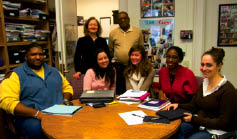On Climate Change...at TC
Two faculty members assess conditions for diversity at the College
Two faculty members assess conditions for diversity at the College
TC faculty members Robert Carter and Celia Oyler are conducting a three-year, mixed methods study of TC’s diversity climate.
The first year of the study involved interviewing more than 200 TC community members, including trustees, senior staff, professional and union staff, faculty (including adjuncts, instructors and lecturers) and students. They also mapped the demographics of each of these groups, quantifying the numbers and percentages of whites, African Americans, Latino/as, males, females and others within each of those categories. They reviewed past reports and other documents about diversity at TC and created a visual “iconography” on campus—signs, posters, statues and other imagery—to analyze what non-verbal messages are displayed that relate diversity.
Now in the second year of the study, Carter and Oyler are conducting focus groups to get the views of TC community members on factors that contribute to the climate for diversity at the College. The groups are organized on the basis of job status and ethnicity to determine collective experiences.
Carter and Oyler also have interviewed unit heads about the grievance procedures available to faculty, students and staff. “What is communicated throughout the material is that individual students or groups are encouraged to address potential grievances through informal processes prior to seeking the support of such offices or individuals as the Ombudsman or Vice Provost,” they write. “Individuals are encouraged to seek the formal assistance of established offices, individuals and/or grievance procedures only after exhausting various informal processes…One of the things that happen in informal systems is that the institution does not know what is going on. There is a sense that the issues that come up are not reported or documented in any way…From a community perspective, informality makes it hard to know how things get handled.”
While there have been other academic studies of diversity climate, the Carter-Oyler project—part of a broader diversity effort that involves a task force comprising faculty and senior administrators—breaks new ground in several ways.
“We’re working in a transformative way, sharing what we learn with faculty, students and staff as we go and using the information and the feedback to inform other phases of the project,” Carter says. “We also take the position that diversity issues differ for each group.” The mix of quantitative and qualitative methodologies is also important. “It’s one thing to deal in perceptions—to say, we think we know what the climate looks like—and another to truly map out that climate with graphs and charts. When you do that, everyone is operating from the same base of information.”
“I think everyone at TC has some knowledge of where they are situated in the community with regards to issues of diversity, but there are few mechanisms to share knowledge and information about how others are situated and how people see general trends at the institution,” Oyler says. “What’s exciting about our work is that now everyone can have access to the same information, which increases their voice in decision-making that affects their own lives.”
The ultimate goal of their research, Carter and Oyler say, is not to compare TC to other institutions, but rather to foster a more widely shared, positive experience around diversity for people at TC.
To date, the two faculty members have completed a preliminary draft of the demographic mapping. While it is too early to share the hard numbers, certain basic trends are emerging. “Overall, the majority of executive staff members and tenured faculty are white, and overall the majority of union staff members are black and Hispanic,” Carter says. “That’s troubling when you consider both the hiring pool of qualified minority doctorates, and also when you compare it to the degree to which gender parity has improved. I don’t think that other institutions are necessarily doing a better job. Our society is able to discuss other kinds of differences among people, but the conversation about race seems to continue to be difficult.”
Carter says he is optimistic about the prospects for change, given the commitment that the College is making to support this project and other current initiatives around diversity.
“For me, the investment in this inquiry is significant, because it breaks past patterns,” Carter says. “It’s charting a new direction. The question is, what gets done with what we find, because it has no value if it’s not used. Members of the community have to insist that it gets used, and leaders have to use it. The leaders have indicated a willingness to do that by the investment they’ve made in this effort, and by their commitment to providing everyone with the same information so that we can all be on the same page.”
Published Thursday, Dec. 16, 2010
